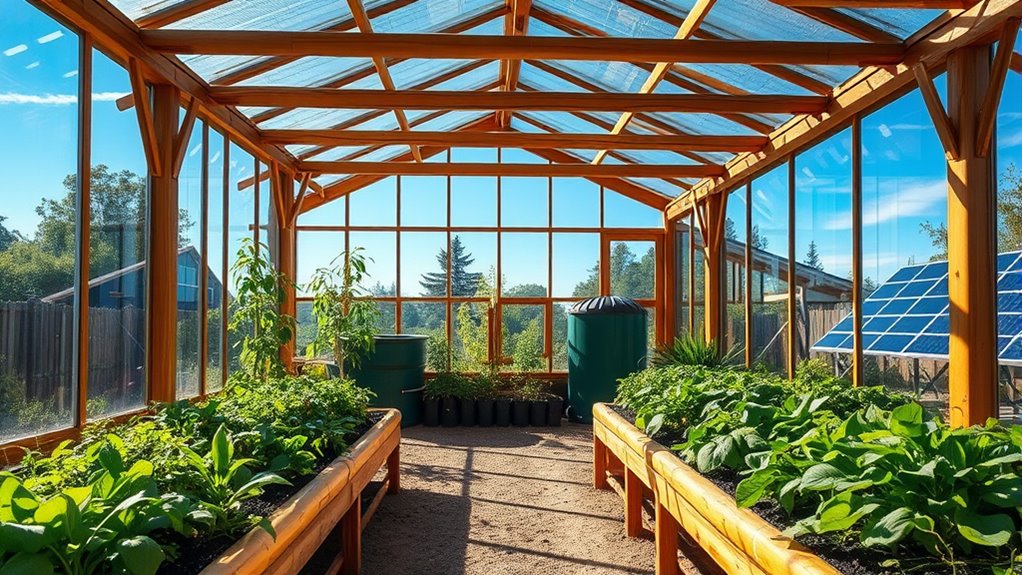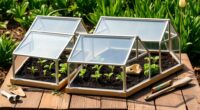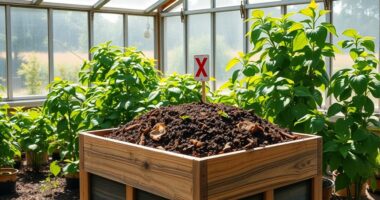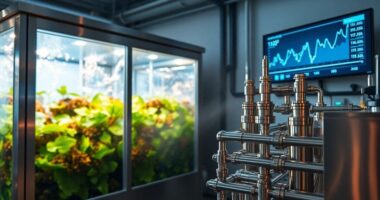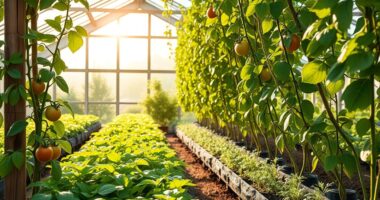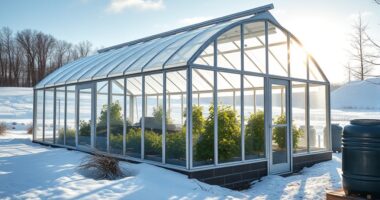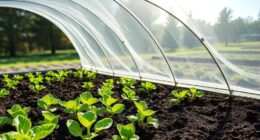For eco-friendly greenhouse construction, consider reclaimed wood, which reduces new lumber demand and adds charm. Innovative recycled plastic panels offer durability while maintaining energy efficiency. You can use energy-efficient glass alternatives like polycarbonate for better insulation. Bamboo is a strong, renewable option too. Don't overlook straw bale insulation for its thermal benefits. Lastly, integrating renewable energy solutions can further enhance sustainability. Explore these materials and discover more ways to create an environmentally friendly greenhouse.
Key Takeaways
- Utilize reclaimed and recycled wood to reduce demand for new lumber while adding unique aesthetic value to greenhouse structures.
- Incorporate innovative recycled plastic panels for durability, impact resistance, and superior thermal performance.
- Choose energy-efficient glass alternatives like polycarbonate for excellent insulation and UV resistance in greenhouse environments.
- Implement bamboo frameworks for lightweight, strong, and renewable construction that supports sustainable practices.
- Use straw bale insulation to enhance thermal efficiency, reduce energy consumption, and promote better indoor air quality.
Reclaimed and Recycled Wood Options
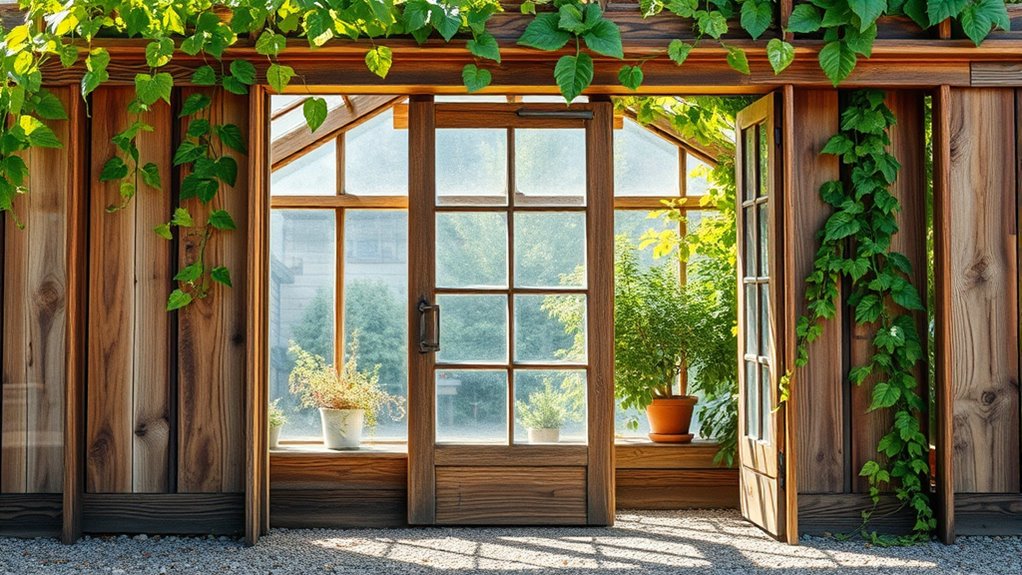
When you consider building an eco-friendly greenhouse, using reclaimed and recycled wood options can significantly enhance sustainability. Reclaimed wood reduces the demand for new lumber, conserving natural resources and minimizing your environmental impact. It offers a unique aesthetic, adding character through its weathered appearance. Plus, it can be cost-effective, reducing your construction expenses. Look for salvaged timber from local yards or demolition sites to repurpose for framing and structural elements. You might even find old lumber for doors and shelving. Just ensure the wood is structurally sound and treated for moisture resistance. Salvaged plywood was used for the greenhouse base and framework in a recent project, demonstrating the viability of recycled materials. Additionally, using responsibly managed forests as a source for reclaimed wood can further enhance your sustainability efforts.
Innovative Recycled Plastic Panels
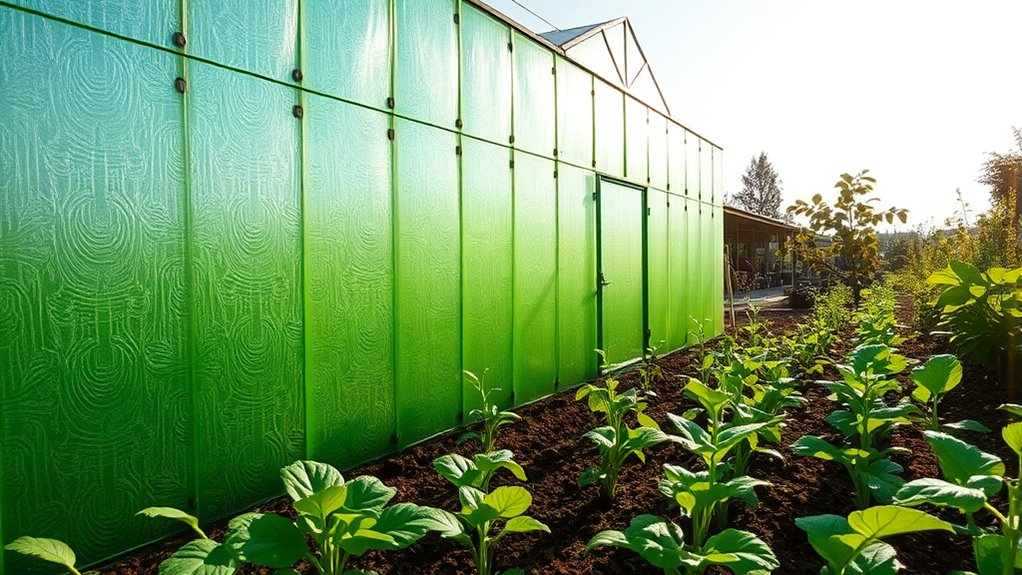
As you explore options for building an eco-friendly greenhouse, consider the benefits of innovative recycled plastic panels. These panels, like polycarbonate, are incredibly durable and resistant to impact, making them perfect for harsh weather conditions. They offer excellent light transmission, similar to glass, while maintaining superior heat retention and UV protection essential for plant growth. Recycled materials contribute to a lower carbon footprint, enhancing the sustainability of your greenhouse. Although they may have a higher upfront cost, their long-term durability and low maintenance can make them cost-effective. You'll find various options, including biodegradable and recycled polyethylene panels, each contributing to waste reduction.
Energy-Efficient Glass Alternatives
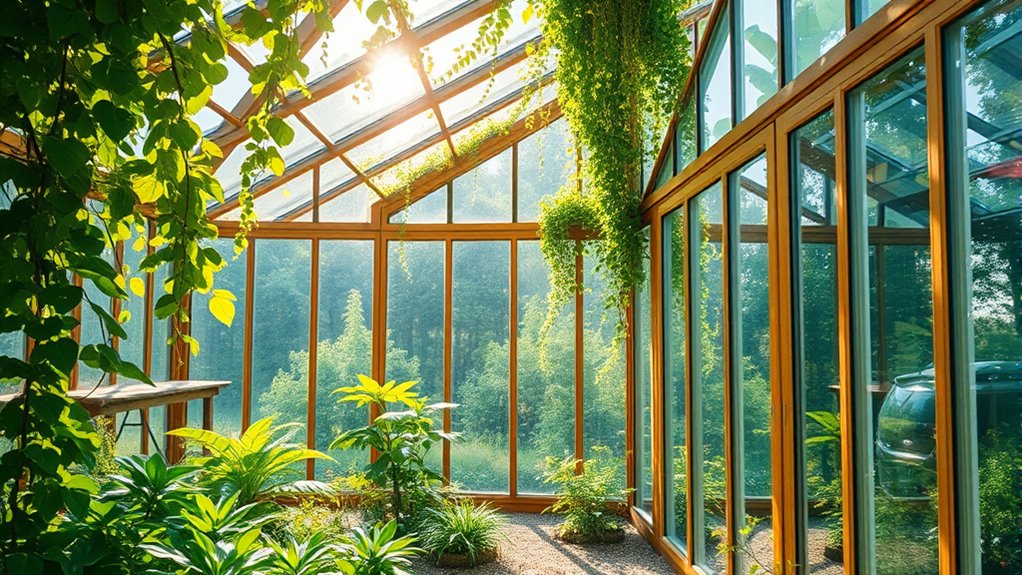
Energy-efficient glass alternatives provide an excellent way to enhance your greenhouse's sustainability and performance. Materials like Plexi and Acrylic Glass offer superior insulation and durability, reducing energy costs while ensuring high light transmission. Additionally, these materials exhibit high impact resistance, making them safer for greenhouse environments. Polycarbonate panels excel in energy efficiency and UV resistance, making them ideal for various greenhouse applications. Low-E glass decreases heat transfer, improving insulation compared to traditional glass. Smart glass technologies can dynamically modulate light, optimizing conditions for plant growth. Additionally, photovoltaic glass panels allow for electricity generation while still letting sunlight in.
Advantages of Bamboo Frameworks
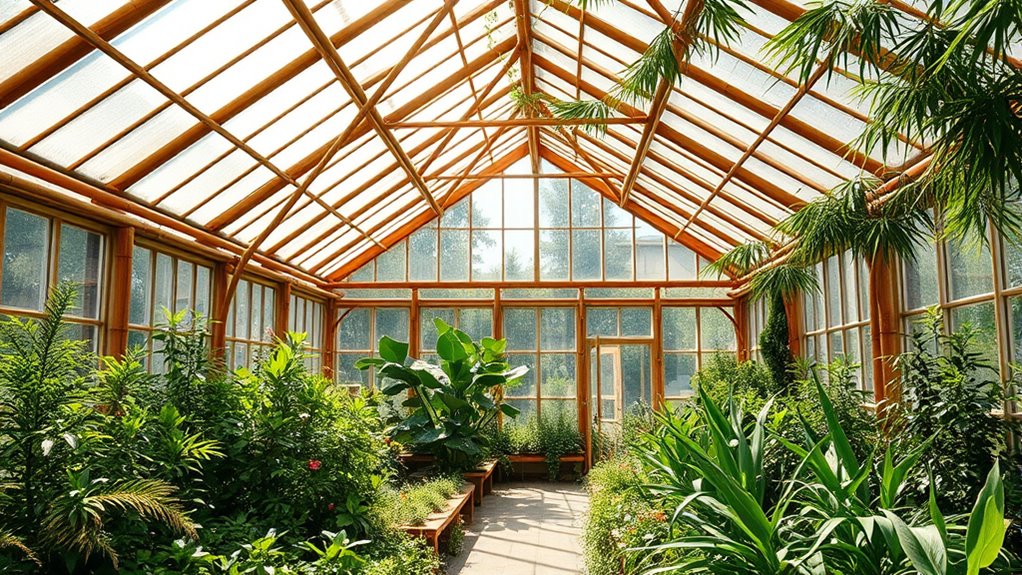
Bamboo frameworks offer a sustainable and efficient solution for greenhouse construction, thanks to their remarkable properties.
As a fast-growing renewable resource, bamboo can be harvested in just three years, making it an eco-friendly choice. Its high tensile strength and flexibility mean it can bear loads without breaking, while its lightweight nature simplifies transportation and assembly.
Plus, bamboo's durability ensures long-lasting structures that require minimal maintenance, saving you money over time. With low environmental impact, it doesn't need pesticides or herbicides, promoting healthier ecosystems. Additionally, incorporating sustainable practices in your greenhouse design can further enhance the environmental benefits of using bamboo.
Choosing bamboo not only reduces deforestation but also supports carbon sequestration, making it a responsible choice for your greenhouse project. You'll enjoy the benefits of cost-effectiveness and sustainability combined.
The Benefits of Straw Bale Insulation
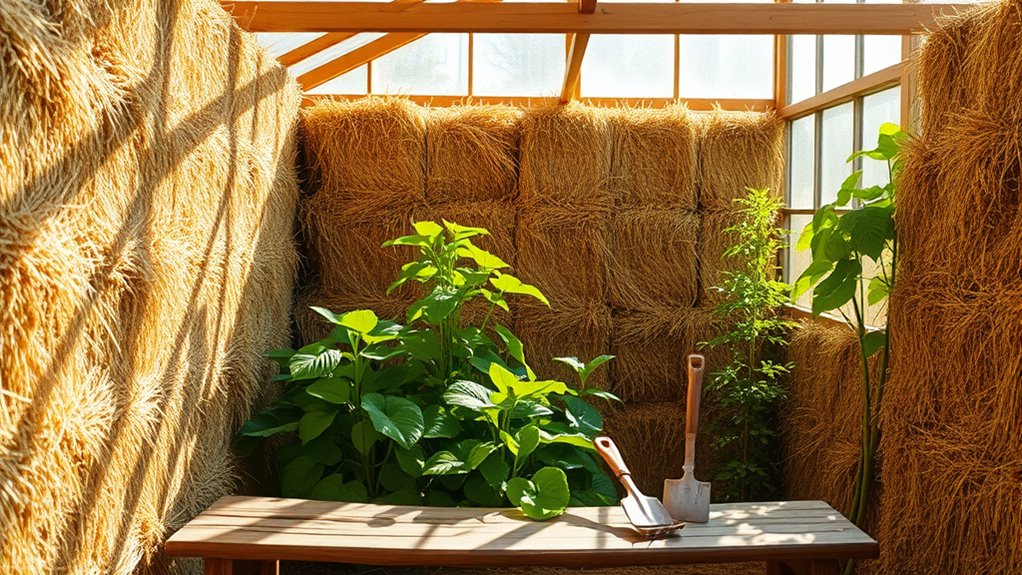
When considering sustainable building materials for your greenhouse, straw bale insulation stands out as a remarkable option. Made from agricultural by-products, straw bales reduce waste and save on costs, making them a budget-friendly choice. Their excellent thermal insulation properties help trap heat, cutting down on energy consumption and ensuring a comfortable environment. Plus, tightly packed straw bales are fire-resistant, adding another layer of safety. Additionally, straw bales provide a head start for plant growth by generating internal heat as they decompose. With proper moisture protection, straw insulation can last for decades, making it a durable solution. Furthermore, straw bales can dampen sound, enhancing your greenhouse's tranquility. In fact, using sustainable materials like straw bales can significantly reduce your environmental footprint while promoting a healthier ecosystem. Additionally, using straw bales can improve indoor air quality by promoting better ventilation and reducing allergens in the environment.
Sustainable Heating and Cooling Techniques
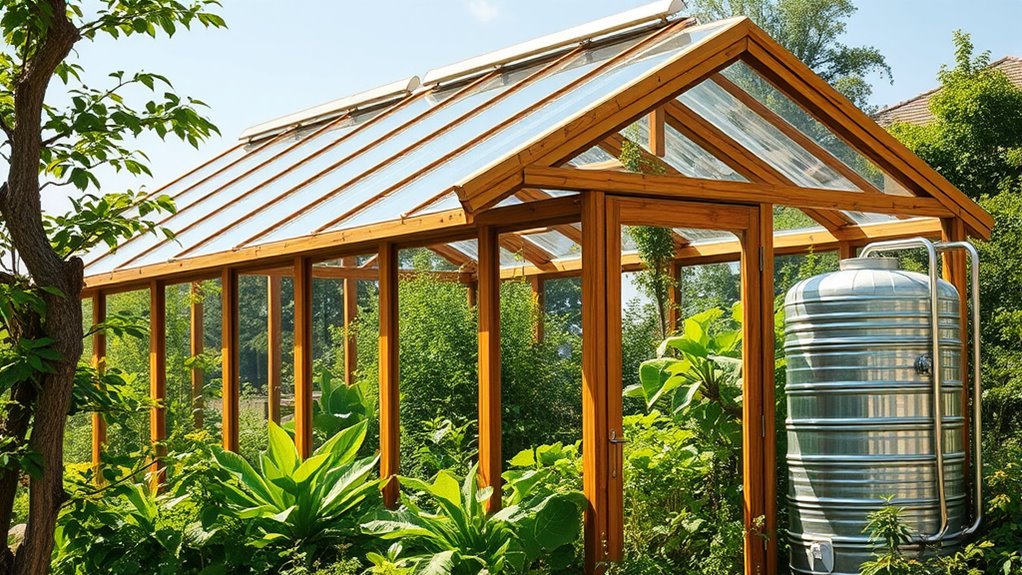
To create a thriving greenhouse environment while minimizing your carbon footprint, consider implementing sustainable heating and cooling techniques.
You can utilize passive solar heating, which harnesses sunlight and thermal mass to maintain warmth naturally. Temperature influences compost heating is another option, generating heat from decomposing organic materials. For smaller spaces, try the candle pot heater method, using terracotta pots and candles for an inexpensive solution. Additionally, clear communication about the greenhouse's heating needs can enhance efficiency and effectiveness in maintaining optimal conditions.
Explore sustainable heating options like passive solar, compost heating, and the candle pot heater for efficient warmth in your greenhouse.
When it comes to cooling, natural ventilation through roof vents and shading devices can effectively regulate temperature without electricity. Incorporating green roofs not only insulates but also cools your greenhouse.
Finally, consider using thermal mass materials to store heat during the day and release it at night, ensuring a stable environment for your plants.
Water Conservation Strategies for Greenhouses
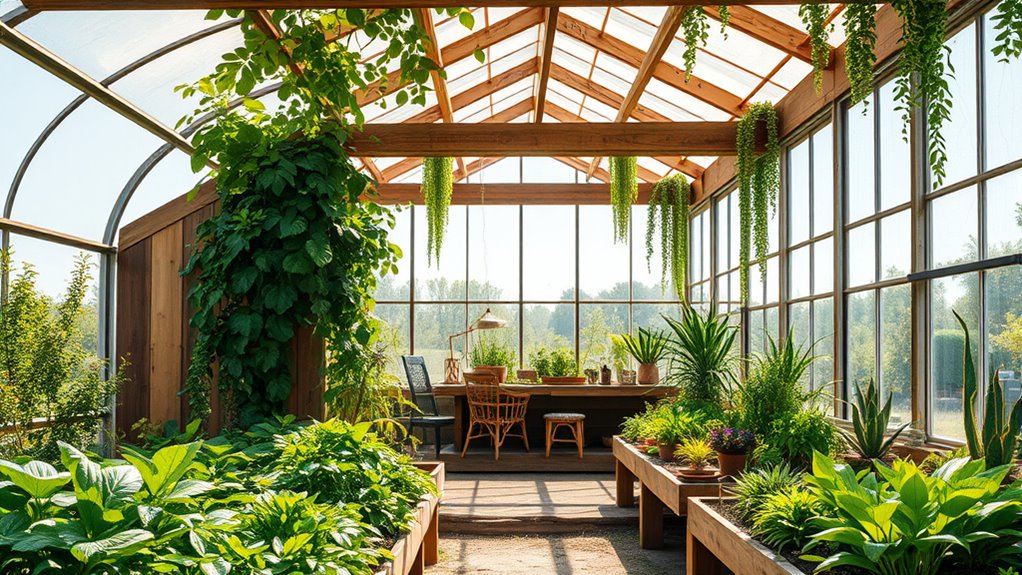
Maintaining a sustainable greenhouse isn't just about effective heating and cooling; water conservation plays a vital role in creating an eco-friendly environment.
Implementing drip irrigation systems delivers water directly to plant roots, minimizing evaporation and runoff. Consider rainwater harvesting to collect and store rain for irrigation, reducing your reliance on external sources.
Use soil moisture sensors to optimize watering schedules, ensuring plants receive just what they need. Closer plant spacing reduces overall water consumption while mulching can help retain soil moisture and prevent evaporation.
Additionally, explore using grey water for irrigation, but monitor sodium and boron levels carefully.
Integrating Renewable Energy Solutions
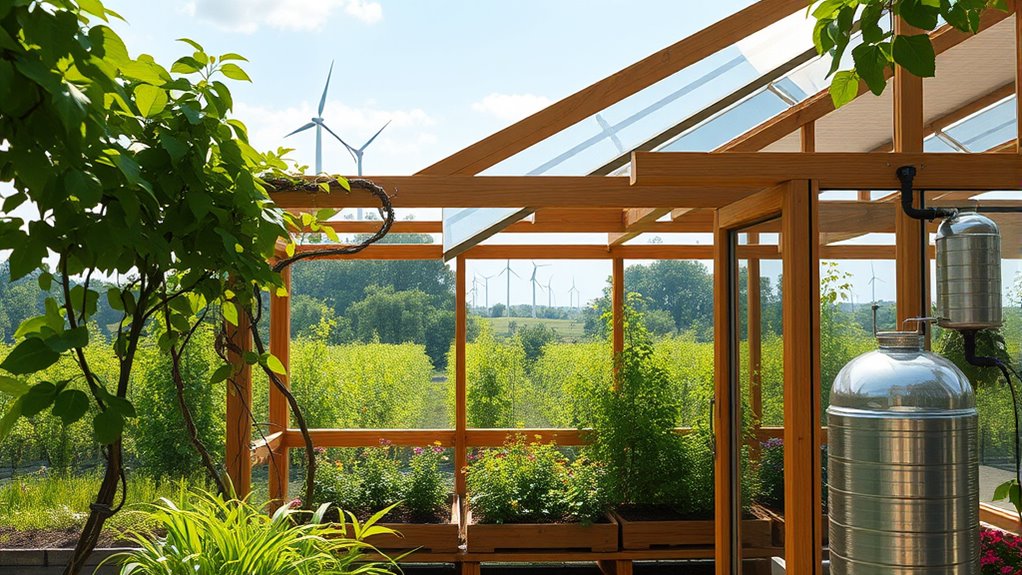
Integrating renewable energy solutions into your greenhouse not only boosts sustainability but also cuts down long-term operational costs.
You can install solar panels on the roof to harness sunlight, reducing your reliance on fossil fuels. If you're in a windy area, consider adding wind turbines for additional electricity.
Biomass systems can convert organic waste into energy, providing a sustainable heat source. Geothermal systems utilize stable underground temperatures for efficient heating and cooling. Additionally, adopting renewable energy sources can significantly lower your carbon footprint while enhancing energy efficiency.
Also, think about combining these sources with energy-efficient systems like LED lighting and heat pumps to optimize energy use.
Best Practices for Sustainable Maintenance
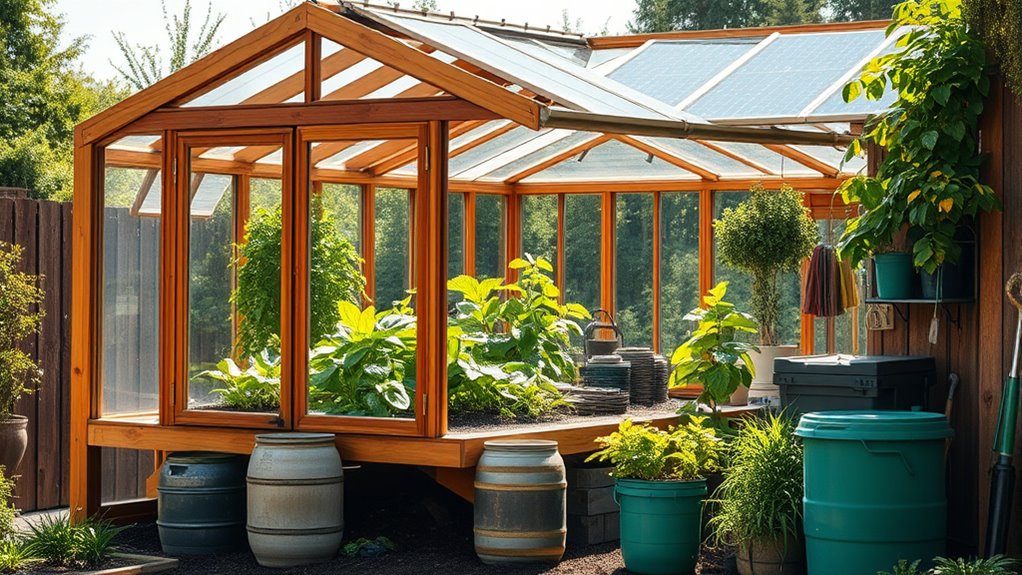
While you focus on growing healthy plants, implementing best practices for sustainable maintenance ensures your greenhouse remains efficient and resilient.
Start by regularly cleaning and inspecting your gutter and drainage systems to prevent water damage. Conduct thorough checks of structural components for wear and apply protective coatings to prolong their life. Proper maintenance plans can provide energy savings and improve productivity.
Calibrate your environmental control systems at each season's start and use automation to enhance energy efficiency.
Adopt water management practices like rainwater harvesting and drip irrigation to conserve resources.
Regularly check fire suppression systems and test emergency alarms for safety.
Finally, maintain sanitation to prevent disease and keep a log of all maintenance activities, ensuring nothing falls through the cracks.
Frequently Asked Questions
How Do I Choose the Right Eco-Friendly Materials for My Climate?
To choose the right eco-friendly materials for your climate, start by assessing local weather patterns and conditions.
Consider materials that offer durability and insulation specific to your environment, like metal frames for heavy snow or polycarbonate panels for hot climates.
Research local resources, like reclaimed wood or bamboo, that suit your area's sustainability goals.
Finally, prioritize energy-efficient options, ensuring they align with your greenhouse's design and your climate's unique needs.
Are There Any Certifications for Sustainable Building Materials?
Think of choosing sustainable building materials like picking apples at a farmer's market. You want the best quality, right?
Certifications like Cradle to Cradle and FSC ensure you're getting materials that are safe and responsibly sourced. GREENGUARD focuses on indoor air quality, while SMaRT looks at social performance.
What Is the Lifespan of Eco-Friendly Construction Materials?
The lifespan of eco-friendly construction materials varies, but many can last decades with proper care.
For instance, recycled steel holds up as well as new steel, while reclaimed wood can endure for years if maintained.
Bamboo's durability reaches up to 50 years, and recycled plastics resist weathering for decades.
Factors like climate conditions, maintenance practices, and material quality all play crucial roles in determining how long these materials will last in your projects.
Can I Use Traditional Materials Alongside Sustainable Options?
Absolutely, you can use traditional materials alongside sustainable options.
Combining materials like wood with bamboo or steel with recycled plastic not only enhances structural integrity but also promotes sustainability.
By selecting the right mix, you can achieve durability while minimizing environmental impact.
It's all about finding that balance, so don't hesitate to experiment with various combinations that suit your project and values.
Your choices can lead to a more responsible construction approach.
How Do I Find Local Suppliers for Sustainable Materials?
To find local suppliers for sustainable materials, start by researching green building networks in your area.
Attend local sustainability events to connect with suppliers and check online forums for recommendations.
Verify their certifications, like LEED compliance, to ensure quality.
Utilize resources like EcoStructure Magazine for databases and consider engaging in community projects to repurpose materials.
Building relationships with these suppliers can lead to better sourcing opportunities and insights into sustainable practices.
Conclusion
As you explore eco-friendly materials for your greenhouse, you'll discover a world of sustainable possibilities waiting to be unlocked. Imagine the satisfaction of nurturing your plants in a structure built from reclaimed wood or innovative recycled plastics. But there's more—think about the energy-efficient solutions and renewable energy sources that could revolutionize your gardening experience. Will you take the leap into a greener future? Your dream greenhouse might be just around the corner, ready to bloom with potential.
